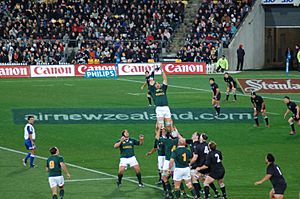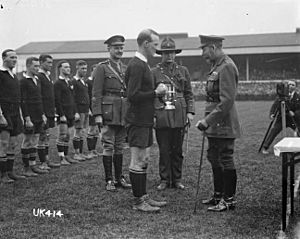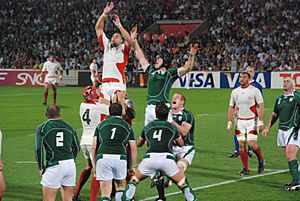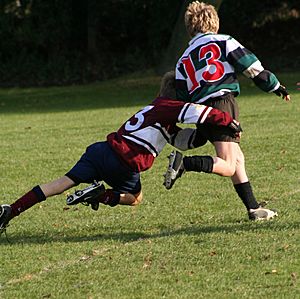Rugby union facts for kids

South African Victor Matfield takes a line-out against New Zealand in 2006.
|
|
| Highest governing body | World Rugby |
|---|---|
| Nicknames |
|
| First played | 19th century, England, United Kingdom |
| Registered players | 8,400,000 |
| Characteristics | |
| Contact | Full |
| Team members | 15 (with up to 8 substitutes) |
| Mixed-sex | Separate competitions |
| Type |
|
| Equipment |
|
| Venue | Rugby field |
| Presence | |
| Country or region | Worldwide (most popular in certain European and Commonwealth countries) |
| Olympic | Part of the Summer Olympic programme in 1900, 1908, 1920 and 1924 Rugby sevens included in 2016 and 2020 |
Rugby union is a ball sport. Two teams of 15 players play against each other. The ball used is oval in shape. The field is a rectangle shape. It is 100 metres long and 70 meters wide. At the ends of the field are two H-shaped goal-posts.
The game is played for 80 minutes in two 40-minute halves.
Contents
History
Primitive forms of football included harpastum, played by the Romans, where two opposing teams competed to throw a large ball into an opposition net, fighting for possession of the ball. Medieval Irishmen played cad, carrying an inflated bladder and using arched trees as goals. The Welsh played an inter-parish game using a wooden ball called cnapan. Frenchmen played soule and Georgians played lelo. "Football" as a game was well established by 1803 at Rugby school and by the 1830s, "running in" with the ball in hand was allowed but subject to hacking and "collaring".
Former Rugby School student Albert Pell is credited with having formed the first "football" team while a student at Cambridge University. Major private schools each used different rules during this early period, with former pupils from Rugby and Eton attempting to carry their preferred rules through to their universities. A significant event in the early development of rugby football was the production of a written set of rules at Rugby School in 1845, followed by the Cambridge Rules that were drawn up in 1848.
Formed in 1863, the national governing body The Football Association (FA) began codifying a set of universal football rules. These new rules specifically banned players from running with the ball in hand and also disallowed hacking (kicking players in the shins), both of which were legal and common tactics under the Rugby School's rules of the sport. In protest at the imposition of the new rules, the Blackheath Club left the FA followed by several other clubs that also favoured the "Rugby Rules". Although these clubs decided to ban hacking soon afterwards, the split was permanent, and the FA's codified rules became known as "association football" whilst the clubs that had favoured the Rugby Rules formed the Rugby Football Union in 1871, and their code became known as "rugby football".
In 1895, there was a major schism within rugby football in England in which numerous clubs from Northern England resigned from the RFU over the issue of reimbursing players for time lost from their workplaces. The split highlighted the social and class divisions in the sport in England. Although the rules of the game were not a factor in the split, the breakaway teams subsequently adopted some rule changes and this became the separate code of "rugby league". The RFU's code thereafter took on the name "rugby union" to differentiate it from rugby league, but both versions of the sport are known simply as "rugby" throughout most of the world.
First internationals
The first rugby football international was played on 27 March 1871 between Scotland and England in Edinburgh. Scotland won the game by one goal and one try to one goal. By 1881 both Ireland and Wales had representative teams and in 1883 the first international competition, the Home Nations Championship had begun. 1883 is also the year of the first rugby sevens tournament, the Melrose Sevens, which is still held annually.
Two important overseas tours took place in 1888: a British Isles team visited Australia and New Zealand—although a private venture, it laid the foundations for future British and Irish Lions tours; and the 1888–89 New Zealand Native football team brought the first overseas team to British spectators.
During the early history of rugby union, a time before commercial air travel, teams from different continents rarely met. The first two notable tours both took place in 1888—the British Isles team touring New Zealand and Australia, followed by the New Zealand team touring Europe. Traditionally the most prestigious tours were the Southern Hemisphere countries of Australia, New Zealand and South Africa making a tour of a Northern Hemisphere, and the return tours made by a joint British and Irish team. Tours would last for months, due to long traveling times and the number of games undertaken; the 1888 New Zealand team began their tour in Hawkes Bay in June and did not complete their schedule until August 1889, having played 107 rugby matches. Touring international sides would play Test matches against international opponents, including national, club and county sides in the case of Northern Hemisphere rugby, or provincial/state sides in the case of Southern Hemisphere rugby.
Between 1905 and 1908, all three major Southern Hemisphere rugby countries sent their first touring teams to the Northern Hemisphere: New Zealand in 1905, followed by South Africa in 1906 and Australia in 1908. All three teams brought new styles of play, fitness levels and tactics, and were far more successful than critics had expected.
The New Zealand 1905 touring team performed a haka before each match, leading Welsh Rugby Union administrator Tom Williams to suggest that Wales player Teddy Morgan lead the crowd in singing the Welsh National Anthem, Hen Wlad Fy Nhadau, as a response. After Morgan began singing, the crowd joined in: the first time a national anthem was sung at the start of a sporting event. In 1905 France played England in its first international match.
Rugby union was included as an event in the Olympic Games four times during the early 20th century. No international rugby games and union-sponsored club matches were played during the First World War, but competitions continued through service teams such as the New Zealand Army team. During the Second World War no international matches were played by most countries, though Italy, Germany and Romania played a limited number of games, and Cambridge and Oxford continued their annual University Match.
The first officially sanctioned international rugby sevens tournament took place in 1973 at Murrayfield, one of Scotland's biggest stadiums, as part of the Scottish Rugby Union centenary celebrations.
World Cup and professionalism
In 1987 the first Rugby World Cup was held in Australia and New Zealand, and the inaugural winners were New Zealand. The first World Cup Sevens tournament was held at Murrayfield in 1993. Rugby Sevens was introduced into the Commonwealth Games in 1998 and was added to the Olympic Games of 2016. Both men and women's Sevens took place at the 2020 Olympic Games in Tokyo.
Rugby union was an amateur sport until the IRB declared the game "open" in August 1995 (shortly after the completion of the 1995 World Cup), removing restrictions on payments to players. However, the pre-1995 period of rugby union was marked by frequent accusations of "shamateurism", including an investigation in Britain by a House of Commons Select committee in early 1995. Following the introduction of professionalism trans-national club competitions were started, with the Heineken Cup in the Northern Hemisphere and Super Rugby in the Southern Hemisphere.
The Tri Nations, an annual international tournament involving Australia, New Zealand and South Africa, kicked off in 1996. In 2012, this competition was extended to include Argentina, a country whose impressive performances in international games (especially finishing in third place in the 2007 Rugby World Cup) was deemed to merit inclusion in the competition. As a result of the expansion to four teams, the tournament was renamed The Rugby Championship.
Point Scoring
A Try is scored when a player 'scores'. A try is worth 5 points. To score a try the player must put down the ball in the 'try area'. The try area is behind the goal-posts.
Once a try has been scored, the team has a chance to score extra points. The goal kicker kicks the ball towards the goal-posts. The ball must pass between the two upright goal-posts and above the cross-piece. If it does, the team is awarded 2 additional points. This act is known as a 'conversion'.
Another method of scoring points is through penalties. When a team breaks the rules, the referee may award a penalty. The goal-kicker kicks towards the goal-posts. The ball must pass between the two upright goal-posts and above the cross-piece. If it does, the team is awarded 3 points.
During play, the goal-kicker can also attempt a 'drop-goal'. The goal-kicker kicks towards the goal-posts. The ball must pass between the two upright goal-posts and above the cross-piece. If it does, the team is awarded 3 points.
Numbers and Positions
Forwards
1 : Loose head prop
2 : Hooker
3 : Tight head prop
4 : Lock / Second row
5 : Lock / Second row
6 : Blind side flanker / blind-side wing-forward
7 : Open side flanker / open-side wing-forward
8 : Number 8
Backs
9 : Scrum-half (or half-back)
10 : Fly half/outside-half/outhalf (or first-five-eighth)
11 : Left-wing
12 : Inside centre (or second-five-eighth)
13 : Outside centre
14 : Right-wing
15 : Fullback
Rules
The laws of Rugby Union whilst difficult at first are easy to pick up.
The key rule to rugby union play is that the person who is carrying the ball at any time cannot pass the ball to a teammate who is closer to the opposition goal line. The ball must always be passed sideways or backwards.
Only the player with the ball may be tackled. Tackling is when the player with the ball is brought to the ground by an opposition player. The opposition player must use their hands to hold onto the ball carrier, and wrestle them to the ground.
When the player with the ball is on the ground, players from the opposition team may stand over him and attempt to grab the ball off them. The opposition players must remain standing ('on their feet'). Meanwhile, the player with the ball will try to pass the ball backwards along the ground to a teammate. His teammates will then move over the player and protect the ball.
During the game, there are four officials who enforce the rules. The referee runs alongside players as they play the game. The referee controls the game.
The two touch-judges patrol the out-of-bounds areas. They also indicate when a goal kick has been successful.
The TMO, or 'television match official', helps the referee with difficult decisions. Most professional games have a TMO.
Kicking
Kicking is very important in rugby. Normally, only the backs will kick. However, you somethimes see the forwards kick. There are different reasons why they may kick. You can kick by doing a drop kick, grubber, up and under, punt, football kick and off a tee.
Images for kids
-
Sébastien Chabal (far left) in number eight position before entering the scrum
-
A scrum between New Zealand's Crusaders and Australia's Brumbies
-
Japanese and Welsh rugby fans in Cardiff, Wales, September 2007
-
A giant rugby ball suspended from the Eiffel Tower to commemorate France's hosting of the 2007 World Cup
-
When codifying Australian rules football in 1859, Tom Wills drew inspiration from an early version of rugby he learnt at Rugby School.
See also
 In Spanish: Rugby union para niños
In Spanish: Rugby union para niños

















